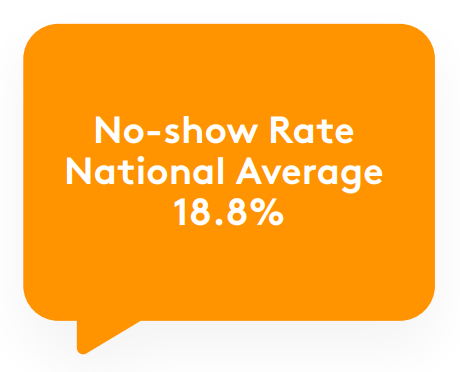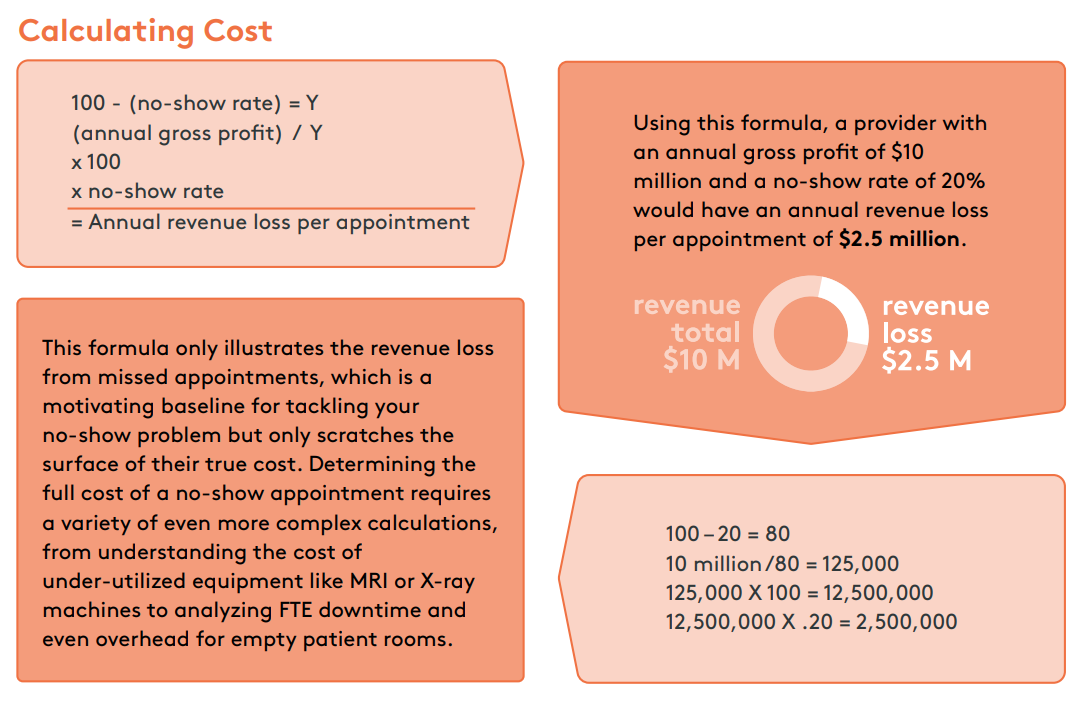The Wild Card
Strategizing Around The Unpredictability And Inevitability Of No-shows
Pressed for Time?
Watch the video to the right and get this white paper content in under 5 minutes— then come back for a deeper dive into our findings by scrolling to the full version below. Or let Haxall know you would like to download a pdf version for later."

Abstract
There is no doubt that patient no-shows are one of the most problematic aspects of practice management. Surveys indicate they are responsible for over $150 billion in industry losses annually. But no-shows don’t just impact revenue; they result in wasted internal resources that can push up the cost of care, stifle provider productivity, prohibit efficient practice operations, minimize access, and delay care for the entire patient population. This paper aims to identify the full impact of appointment no-shows and how to create strategies to combat them to the benefit of your patient population, operations, and the profitability of your organization.
Part One: Predictably Unpredictable
Patient no-shows are a persistent problem impacting all levels of healthcare, from patient outcomes to revenue. While no-show rates can vary greatly, as low as 5% to over 50% in some cases, the national average for any provider type sits at 18.8%. Given their significant impact, great effort has been expended attempting to develop a formula for successfully predicting whether a patient will no-show. Studies have been conducted analyzing a variety of factors, including a patient’s personal no-show history, patient demographics, appointment times, day of the week, rurality or provider location, appointment lead time, insurance coverage type, visit type, and medical specialty.


Though studies like these have yielded results that illustrate a higher likelihood of no-shows in certain instances, the variability of patient and practice types make it impossible to develop an industry standard. Predictability models, to be of any use, must be created in house based on the unique circumstances of your practice. When no-shows can be predicted before they occur targeted measures can be taken to offset their impacts, such as reducing staff or overbooking appointments.
Due to the duration of these studies and the resources needed to execute them, many practices prefer to accept the predictable unpredictability of no-shows and strategize around their overall rate, rather than the individual factors contributing to them. While this is not the most precise approach, it can still reveal patterns in patient behavior and allow for monitoring the success of new strategies.

The above simple formula can be used to calculate your no-show rate. To get a more accurate rate, you should average together calculations from several weeks, if not an entire year. These calculations can reveal broader patterns of behavior when analyzed monthly, seasonally, or by appointment type.
Part Two: Calculating the Impact
Appointment no-shows impact patients and providers in a variety of interconnected ways making calculating their full impact difficult. But understanding the significance of no shows at your practice is important. It can offer perspective on operations and serve as motivation for strategic changes. In this section, we distill the overall impact into three essential areas: patient outcomes, operations, and revenue.
Patient Outcomes
When patients don’t follow through with a scheduled appointment the result is always delayed care— if not for them then the patient who would have filled their appointment slot. Studies have proven without a doubt that delays in care have negative impacts on long term health increasing morbidity and mortality risk regardless of patients’ underlying, preventable, or treatable medical conditions.
Interest in the effect of delayed care has been renewed recently due to the pandemic. A variety of pandemic-related factors resulted in care delays, from a lack of available appointments to patient financial difficulties. A Harvard study identified as many as one in five patients delayed care during the pandemic, and 57% of those suffered negative health consequences as a result.
57% of patients who delayed care suffered negative health consequences.
There are non-health-related consequences to delaying care as well. Sicker patients are more difficult to treat, exacerbating resources and putting a greater strain on providers. They are also more costly to treat, impacting providers’ financial margins. Increases in the cost of care are often passed on to patients which can create new barriers to care— creating a vicious cycle.
4 in 10 Americans report delaying care due to cost concerns.
Costs associated with patient outcomes can extend beyond margins for the cost of care. Value-based care models tie reimbursement rates directly to patient outcomes, rewarding (or penalizing) providers for readmission rates and successful preventive care. While these reimbursements make up a small percentage of most providers’ overall revenue, the data indicates they are growing in popularity. Over 40% of healthcare payments stem from a value-based reimbursement model.
More than 40% of healthcare payments come from value-based reimbursements.
Operations
Perhaps the most noticeable impact of patient no-shows is they can stack the deck against operational efficiency for everyone involved. The idle time that was intended for patient care results in wasted personnel, space, and equipment resources. Failed resource utilization then creates further issues from impacting the ability to provide quality care to affecting overall system performance.

Revenue
Revenue is typically the biggest motivating factor in addressing patient no-shows, which cost the industry approximately $150 Billion annually. The impact on revenue varies greatly based on the visit or practice type, though conservative estimates put the cost of an individual missed appointment around $200. In addition to the revenue loss from the appointment itself, other factors like the costs incurred from poor resource utilization must be considered to understand how no-shows are directly impacting your bottom line.

Calculating Cost
In order to begin to determine the true cost of no-show appointments at your practice you will first need to determine an estimate per visit gross profit. Gross profit may be located on annual financial reports or tax returns. If you do not have access to these, you can use a net receivables or payment report from your EMR.
Once you have established gross profit, find the total number of appointments for that same period. Once an appointment has been billed, they are typically labeled “encounters” in your EMR and you should be able to access a summary report to retrieve this data. Next, divide your total gross profit by the total number of encounters.

To ensure greater accuracy, it’s recommended that you calculate three years of data and average those results. This number should serve as a baseline for revenue loss per no-show. The minimum revenue loss can now be determined by multiplying your gross profit per appointment by the number of no-shows for any period. You can get a reasonable estimate for this number by reverse engineering the formula, using your no-show rate (from part one of this paper) and your annual gross profit totals. Again, average three years results for better accuracy.

Idle FTE hours
How many hours of downtime are created a week from appointment no-shows?
What are accumulative costs for clinical, lab, physicians, or other staff?
Equipment, diagnostic, and testing resources
How does underused equipment translate to the bottom line?
How would revenue be impacted if you must outsource these services?
Physical space
How are no-shows resulting in unused space, empty patient rooms, etc?
How does this translate to real estate and overhead costs?

Part Three: Why No-shows Happen
Several studies have been conducted to determine the reasons that patients miss appointments. Many of them are directly related to common access barriers, such as financial or transportation struggles. Others, like bad weather or simple forgetfulness, can be chalked up to human nature. While some fall on the shoulders of the provider, these range from personal reasons such as a bad previous experience to poor access management or a lack of reminders. T develop a comprehensive strategy for minimizing no-shows, you must first understand the underlying causes.
Common Access Barriers
In a recent survey, nearly 24% of patients identified common barriers to access, such as transportation, as the reason they missed an appointment. Work or childcare conflicts and financial issues are also common. While some are unavoidable, some of these causes can be minimized through general efforts to improve access. For example, 3.6 million people skip medical care annually due to transportation challenges. Improving patient education about public transportation, ride share programs, or partnering with a ride service can help eliminate this issue.
Human Nature
To err is human… and most of the reasons that patients no-show can be chalked up to just that. More than 50% of patients simply forget their appointments, while 28% get the appointment date or time wrong. Beyond miscommunications and bad memories, patients also said they skip appointments for too bad (or good) weather, because they were feeling better, or that they just lacked the motivation to go. Of course, not all of these can be addressed by the provider but most of them can be remedied with a robust reminders strategy.
Provider Issues
The final set of reasons that patients miss appointments is related directly to their provider. Studies have identified emotional issues, such as negative feelings from a previous bad experience, feeling of disconnect with their provider, or the perception of disrespect as common reasons patients decide not to show up for their appointments. Fears about the appointment, be it a procedure or diagnostic outcome, are also common. This illustrates a need for providers to improve their patient experience, providing more personalization and better communication at the time of service.
In addition to emotional issues, the patient’s administrative experience can play a part. Long wait times are frequently cited as reasons patients chose not to come. And the phone experience is almost always responsible for why patients fail to cancel or reschedule. If a patient is experiencing anxiety about their visit or has a last-minute conflict, they are not likely to wait long on the phone. How long are they willing to wait? Countless surveys have attempted to answer this question. While the reason and circumstances around the call play a part, generally the majority of patients will not wait longer than two minutes and their sentiment declines as time goes on.
Part Four: Strategies For Minimizing The Impact
There is no one solution for patient no-shows, but with an understanding of your patients' behavior, how your organization may be contributing, and the tools available to improve access you can minimize their impact. Providers should consider all of their options, many of the proven strategies in this section are low-lift with minimal cost. An effective strategy approaches the issues from multiple angles, working to improve the patient experience alongside any obstacles to care.
Virtual Health
Out of necessity, providers increased their reliance on virtual care during the pandemic — a move so well received by patients that many still prefer virtual visits today. In fact, studies show that 62% of patients prefer telehealth if there is no reason to be seen in the flesh. Telehealth has several advantages over traditional in-person visits, primarily it eliminates transportation barriers and is more convenient for patients to fit in whether they are facing a scheduling conflict or you are trying to fill in same-day appointments. And they have been proven to reduce no-shows. One study showed that virtual appointments during the pandemic had a no-show rate that was nearly 80% less than in-office visits and compared a 7.5% rate for virtual visits to that of almost 30% for in person appointments before COVID-19. The same holds true for specialties; an unrelated study discovered that telehealth reduced the likelihood of no-shows by 79%. Beyond convenience and improved access, virtual health can boost patient satisfaction. When surveyed more than half of patients said they were more satisfied with their virtual appointments than in-person care.
Robust Reminders
When the majority of patient no-shows can be attributed to forgetfulness or getting the appointment details wrong, it stands to reason that a robust reminders program is the most direct way to remedy the problem. Studies have shown that reminders alone can reduce your no-show rate by more than 40%. An effective program deploys multiple touches in an omnichannel approach, ensuring you reach patients through the channels they prefer. Reminders aren’t just good practice, they are an expectation. Over 75% of patients want reminders for prescription refills, annual checkups, routine testing, and preventative care— 83% expect them for appointments.
Improve Access
Some of the usual obstacles to access are responsible for your no-show rates. Improving the overall access experience can eliminate a lot of these challenges for patients. Assessing call center performance is an easy place to start. Minimizing hold times and offering extended phone hours are two common areas that can have a major impact on the ease of rescheduling for patients. Additionally, your scheduling workflows and guidelines may need to be reviewed and reformed. Outdated practices like block scheduling can limit appointment availability making it more difficult for patients to find a time that works for them. If it isn’t already, patient outreach should be worked into your regular scheduling workflows, helping to remind them of scheduled appointments but also of care needs coming due that need to be scheduled.
Offer Location Flexibility
Another way to create scheduling convenience for patients is to offer location flexibility. Many organizations are still decentralized making it difficult to schedule across their various locations. By moving towards a centralized model, you give schedulers the ability to more readily offer patients options, eliminating lengthy holds, handling times, and transfers— maintaining a higher quality of service and better patient experience.
Collect Patient Preferences
There are two major benefits to collecting data on patients’ preferences when it comes to scheduling and communication. First, this allows you to conduct more effective outreach, maximizing efforts by communicating on channels you know will reach them. In the same vein, knowing a patient’s preference for appointment time or day of the week means you can improve the efficiency of scheduling calls, offering from the onset more appealing and convenient options. This level of personalization also helps to boost the patient experience. The second big benefit is the ability to analyze patient preference data. Analysis can tell you what appointment options are most popular, by demographic, specialty, physician, or service type, so you can align your practice operations for optimized scheduling potential.
Smarter Scheduling
No-shows can be combated by smarter scheduling. Overhauling your existing scheduling practices may not be necessary but understanding them and being able t identify trouble areas, to minimize downtime and maximize your scheduling potential is. This requires analyzing the effectiveness of your access processes individually and as a whole. Many organizations discover that complexities in their scheduling guidelines, like designated days for appointment types or blocked time for batching at the end of the day, inhibit the flexibility that could improve access for patients. Also, upon review, many find room for improvement in specific areas, like referral management, that when remedied have a major impact on scheduling volumes— helping to fill the gaps created by no-show patients.

Upping the Ante
Gambling With Cancelation Fees
Many organizations institute no-show penalties or late cancellation fees in an attempt to minimize appointment no-shows. Considering the many ways patient no-shows impact a practice, from operations to revenue, the philosophy behind the fees is to not just act as an incentive but to hit patients where it also hurts— this can be a big mistake.
Studies, like many referenced in this paper, have illustrated time and time again that no-shows are rarely intentional, most can be attributed to unpredictable and unavoidable circumstances or access failures on the part of the providers themselves. In today’s competitive healthcare market, punishing a patient for circumstances beyond their control may only serve to alienate them from your system and drive them to seek care elsewhere.

Additionally, implementing penalty fees for missed appointments complicates your scheduling workflow and burdens your access staff. First, not all patients can be charged. Patients with certain insurance coverage, like Medicare and Medicaid, are exempt from no show fees which can cause headaches for the billing department. Fee policies also put schedulers in the position of the enforcer and inevitably lead to desperate calls from patients who simply cannot afford their care on top of the cost of a mistake… resulting in delayed care for patients and discouraging appointments that aren’t necessary.
When you choose cancellation fees instead of improving access you are sending the message to patients that the needs of your business come ahead of the realities of their lives— and gambling with patient confidence and loyalty.
Conclusion
While there is no simple solution, a no-show problem is not without hope. Organizations that are willing to conduct a thoughtful analysis of their access experience, patient outreach practices, and the unique needs of their patient community will have little difficulty gaining the insights necessary to identify the underlying causes and develop an effective strategy. We have illustrated a variety of strategic improvements, many of which simply improve patient access in general, that also work to eliminate patient attendance problems. What all of these strategies have in common is a patient centered approach to the problem, working to minimize contributing factors by creating greater conveniences, more scheduling opportunities, and a better patient experience.
Smart providers know that patients hold all of the cards, and successful strategies create a care environment that inspires patient loyalty and retention.
Sources:
1. Jain, S. H. (2019, October 6). Missed Appointments, Missed Opportunities: Tackling The Patient No-Show Problem. Forbes. Retrieved January 13, 2023, from
https://www.forbes.com/sites/sachinjain/2019/10/06/missed-appointments-missed-opportunities-tackling-the-patient-no-showproblem
2. Kheirkhah, P., Feng, Q., Travis, L. M., Tavakoli-Tabasi, S., & Sharafkhaneh, A. (2016, January 14). Prevalence, predictors and economic consequences of no-shows. BMC health services research. Retrieved February 6, 2023, from https://www.ncbi.nlm.nih.gov/pmc/articles/PMC4714455/
3. Marbouh, D., Khaleel, I., Al Shanqiti, K., Al Tamimi, M., Simsekler, M. C. E., Ellahham, S., Alibazoglu, D., & Alibazoglu, H. (2020, June 4). Evaluating the impact of patient no-shows on service quality. Risk management and healthcare policy. Retrieved February 6, 2023, from https://www.ncbi.nlm.nih.gov/pmc/articles/PMC7280239/
4. Gertz, A. H., Pollack, C. C., Schultheiss, M. D., & Brownstein, J. S. (2022, August). Delayed medical care and underlying health in the United States during the COVID-19 pandemic: A cross-sectional study. Preventive medicine reports. Retrieved February 6, 2023, from https://www.ncbi.nlm.nih.gov/pmc/articles/PMC9254505
5. Harvard T.H. Chan (2021). One in five in U.S. report delayed health care during pandemic. Hsph.harvard.edu. Retrieved February 6, 2023, from
https://www.hsph.harvard.edu/news/hsph-in-the-news/one-in-five-in-u-s-report-delayed-health-care-during-pandemic/
6. Alex Montero, A. K. F. @audrey__kearney on T. (2022, July 14). Americans' challenges with health care costs. KFF. Retrieved February 6, 2023, from https://www.kff.org/health-costs/issue-brief/americans-challenges-with-health-care-costs/
7. RevCycleIntelligence. (2021, December 22). The state of value-based reimbursement, financial risk in healthcare. RevCycleIntelligence. Retrieved February 6, 2023, from https://revcycleintelligence.com/features/the-state-of-value-based reimbursement-financial-risk-in-healthcare
8. Bill Toland (2013, February 24). No-shows cost health care system billions. Gazette. Retrieved February 8, 2023, from https://www.post gazette.com/business/businessnews/2013/ 2/24/No-shows-cost-health-care-system-billions/stories/201302240381
9. MGMA, Versus. (2017). Maximizing Patient Access and Scheduling. Retrieved February 9, 2023, from https://mgma.com/MGMA/media/ les/Re ources/PatientAccessSchedulingResearchReport-INTER_FINAL.PDF
10. American Hospital Association (2017, November). Health behaviors transportation and the role of Hospitals. HPOE.org. Retrieved February 9, 2023, from http://www.hpoe.org/Reports-HPOE/2017/sdoh-transportation-role-of-hospitals.pdf
11. Ofei-Dodoo, S., Kellerman, R., Hartpence, C., Mills, K., & Manlove, E. (2019, August 21). Why patients miss scheduled outpatient appointments at Urban Academic Residency Clinics: A qualitative evaluation. Kansas journal of medicine. Retrieved February 9, 2023, from https://www.ncbi.nlm.nih.gov/pmc/articles/PMC6710029
12. Lacy, N. L., Paulman, A., Reuter, M. D., & Lovejoy, B. (2004). Why we don't come: Patient perceptions on no-shows. Annals of family medicine. Retrieved February 9, 2023, from https://www.ncbi.nlm.nih.gov/pmc/articles/PMC1466756/
13. ICMI. (n.d.). What do customers really think about long wait times? Retrieved February 10, 2023, from https://www.icmi.com/resources/2017/what-do-customers-really-think-about-long-wait-times
14. Brenden Drerup, Jennifer Espenschied, Joseph Wiedemer, Lisa Hamilton (2021, March). Reduced no-show rates and sustained patient satisfaction of telehealth during the COVID-19 pandemic. Telemedicine journal and e-health: the official journal of the American Telemedicine Association. Retrieved February 11, 2023, from https://pubmed.ncbi.nlm.nih.gov/33661708/
15. CVS Health. (2022). Health Care Insights Study 2022. Retrieved February 11, 2023, from https://www.cvshealth.com/news/research-reports/health-care-insights-study/health-care-insights-study-2022.html
16. Cordina, J., Fowkes, J., Malani, R., & Medford-Davis, L. (2022, August 4). Patients love Telehealth--physicians are not so sure. McKinsey & Company. Retrieved February 11, 2023, from https://www.mckinsey.com/industries/healthcare/our-insights/patients-love-telehealth-physicians-are-not-so-sure
17. Journal, P. A. M. (2020, June 5). The effect of patient reminders in reducing missed appointment in medical settings: A systematic review. PAMJ - One Health. Retrieved February 11, 2023, from https://www.one-health.panafrican-med journal.com/content/article/2/9/full/
About Envera Health
Envera Health provides comprehensive engagement partnerships for healthcare organizations seeking to transform the patient experience and simplify the care deliver y process. Supported by a unique CRM-driven engagement center, we other a complete suite of patient engagement solutions custom-designed to improve operational efficiency and enable steady growth.
